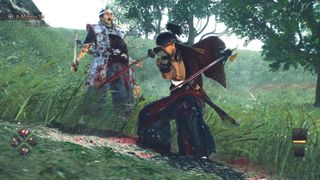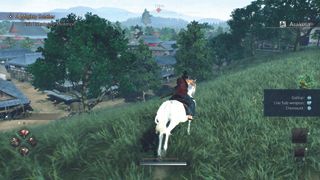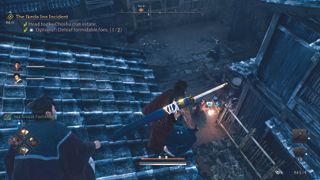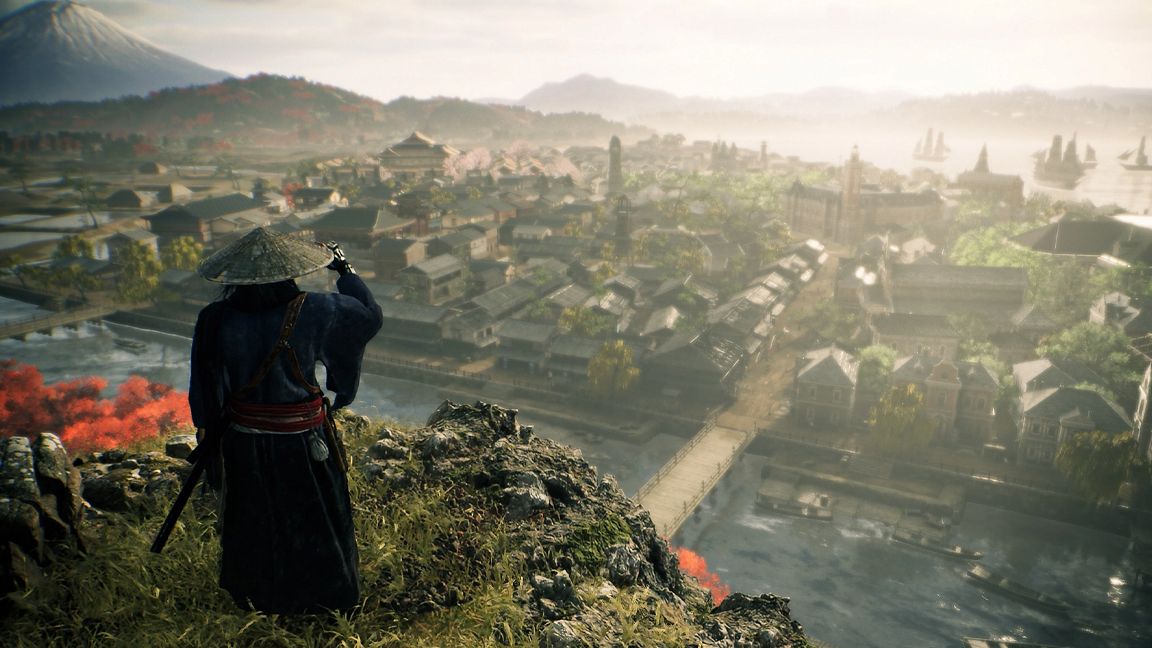Publisher Koei Tecmo
Developer Team Ninja
Platform Xbox Series X / S, PlayStation 5 (reviewed), PC
Release Out now
Price $79.99 / £69.99
Sword fights that demand skill and patience, historical authenticity (to a degree), apparently effortless decapitations that are equal parts horrific and hilarious… whatever you want from a game featuring samurai, there’s a chance it’s in Rise of the Ronin somewhere. There are some undeniably shonky elements, sure, yet they melt into the charm.
Writing on the PlayStation Blog at the end of 2023, Team Ninja’s Fumihiko Yasuda described Rise Of The Ronin as “Our biggest game to date”, and as I play I see that this can be interpreted in multiple ways. The obvious interpretation, of map size, certainly applies. Taking place in late 19th-century Japan, in the final years of samurai and ronin, the story is spread across three areas of the country: Yokohama; Edo (renamed Tokyo shortly after the events of the story); and Kyoto. Each is a large map full of missions, buildings, fields, people, and areas that you’ll only see a fraction of if you pinball between story missions.
It’s also the developer’s biggest game in terms of storytelling scope. It’s set during a very specific period in Japanese history, when discontent with the ruling shogunate – and specifically the way that it handled dealings with Western governments – provoked widespread discontent, and eventually civil war.
The more I look into this period of Japan’s history, the more impressed I become with Team Ninja’s attention to detail, and its ability to blend historical facts into its action game. There aren’t many games where studying the history of 19th-century Japan can mean stumbling into story spoilers, but this is certainly one of the few.
Rise of the Ronin review: bloody and huge

Some facts and events are necessarily tweaked and twiddled with in order to make for a better game. This is often to accommodate the presence of your ronin, just about the only major character in the game who can’t be found in the history books. You can customise their presentation to a surprising degree (even after you start playing, if you wish), right down to the tone of their voice, not that they usually have very much to say. They tend to be the strong, silent type.
There’s character levelling, but this isn’t the drawback that it so often tends to be. We find that we manage to stay ahead of recommended mission levels, without even trying, right up until the climactic fight. Weapons and gear are assigned levels too, each item having its own stat boosts which, after a point, can be swapped between pieces. Legendary gear offers extra benefits if you equip a whole set, although we prefer to mix and match, keeping those numbers high.
There is a variety of weapon types, and the historical angle of the gradual Westernisation of Japan also bleeds in here. There are katanas and oxtail blades, but also bayonets, spears, and sabres. You might take out enemies from a distance with a bow for stealth, or with an American rifle for power. You earn weapon proficiency as you fight, one reason that we tend to stick with the same few weapons (dual blades backed up by a sword big enough to surf on).
The core combat experience is, simply put, one of the best sword-to-sword systems out there, simple yet demanding. At a fundamental level, counters are the key to success. You can block, you can dodge, but knocking your opponent’s weapon away at the precise moment that they strike gives you a brief but important advantage. A successful ‘counterspark’ reduces the enemy’s maximum Ki (stamina) and makes them panic temporarily, leaving them open to attack.
Rise Of The Ronin review: smart combat design

Conversely, you want to keep a close eye on your own Ki bar at all times. If it runs out you won’t be able to act, leaving you utterly helpless for a few seconds – and a few seconds is all your opponent will need to slice huge chunks off your health bar. This is where the ‘blood gauge’ comes in. As you land successful hits, your weapon becomes bloodied. A quick tap of the controller immediately after an attack shakes the blood off and restores an amount of Ki proportionate to the amount of blood built up. Ki is required for everything in combat – attacking, blocking, dodging, counters – so maintaining it, and choosing your actions carefully but quickly, is crucial.
Another layer to combat is the use of stances. There are a number of stances in the game that run on a rock-paper-scissors system, with the vast majority conferring either an advantage or disadvantage against another. The most important aspect of this is the ease with which you’re able to counter.
Fortunately – and a huge reason why combat is challenging rather than infuriating – each opponent is accompanied by a little icon displaying your current stance’s relationship to theirs. See that dreaded red downwards arrow? Switch to another stance with your current weapon, or swap to another with a stance that works to your advantage. Switching between stances is a little awkward, requiring you to glance at the corner of the screen to see which one of those available is best, but we can forgive that.
The end result is a combat system that ruthlessly punishes button bashing, and rewards careful play with an adrenaline rush of satisfaction each and every time you make it sing your tune. Countering a powerful attack indicated by the traditional videogame red glow, and/or a series of attacks in rapid succession, is tricky – but immensely pleasing to get right and follow up with some devastating swipes of your own. You’ll always know that you earned it, too, as different enemies with different weapons will have varying speeds and rhythms of attack to dance with.
Rise Of The Ronin review: a striking open world

And when the fight is over? When you finish your enemy off? When it comes to nameless grunts, the kills are wonderfully brutal. Blades through the chest, heads spinning through the air, torsos waving goodbye to legs… you can turn the gore off if it’s a bit much for you, but it’s so gleefully over-the-top, we find it impossible to be grossed out.
As this is a Team Ninja game, you may now be worrying that it’s usually going to be your head that takes a tumble, but fear not; this is also the studio’s biggest game in terms of the audience it’s appealing to. There are three difficulties to choose from, and you can switch between them during the game at checkpoints. The highest will satisfy those who relish the traditional Team Ninja challenge, and the lowest is probably equivalent to ‘normal’ for most developers, in that you’ll be presented with a challenge without suspecting that your PS5 actively hates you.
This is the developer’s take on an open world experience, though, so it’s not a constant onslaught of intense combat. There’s a heavy emphasis on story with plenty of dialogue, most of it spoken by famous figures from Japanese history. You’re introduced very early on to Ryoma Sakamoto, who accompanies you for much of the main story and many side-missions. His depiction here seems to be somewhat more relaxed and less politically active than the real Sakamoto was, but the important thing is that he’s a memorable and likeable character.
There are some instantly familiar open world tropes. Some areas will be under enemy control until you’ve sliced up enemies in certain spots, and you’re rewarded with gear and new missions for your trouble. People will call out to you as you pass, offering side-missions. There are bonus activities to chase down, such as taking photos of certain areas and finding cats. You’re never forced through any of this before being allowed to progress the story, though. You’re always in control of how much or how little you stray off course, and that’s a big ol’ tick in our book.
Rise Of The Ronin review: undercooked ideas

There are some clear signs that this is made by a team used to creating more linear experiences, in ways both good and bad. One huge plus is that the flow of play is little short of immaculate. We’ve already mentioned that there’s no forced funnelling through side-activities, but there’s also an overarching determination to keep things going at pace. The maps are large, but there are no attempts to emphasise this by placing objectives miles apart – or, at least, no great distances to cover at an agonisingly slow speed.
It’s not long before we’re given our first horse, who we can summon like a carrot-loving genie at almost any time. Combined with the fact that fast travel spots are scattered with great generosity across every map, we find that no journey ever feels like a chore. There are other traversal options, but these are implemented with significantly less success.
You’ve probably seen the glider (given to you very early on) and, while it’s useful in certain situations, it tends to plummet to the ground within seconds, feeling about as aerodynamic as a television set. Fun when launched from a great height, useful for little other than making a big jump otherwise. Then… there’s the grappling hook. Oh, this could have been so good. It should have been so good. It’s occasionally useful in combat for hurling explosive barrels or interrupting enemies, but outside of fights, it can only be used on nominated bits of scenery. We appreciate that the freedom to attach it anywhere would doubtless have thrown up plenty of level and combat design headaches, but we can’t help but be disappointed.
When the hook does come into play, it’s often to support a stealthy approach. There are no instafail stealth sections (phew!), but it’s sometimes an option. Stalking enemies from rooftops can be fun, especially once we’ve unlocked the ability to use the hook to yank them up from the ground to take them out. Stealth is great when it works, but its implementation feels rather half-hearted.
Rise Of The Ronin review: multiplayer stealth

Sometimes I’ll clear a room or an area quickly and quietly in seconds, picking off a straggler or two before rapidly assassinating the few remaining enemies. More often than not, though, it’s simply not possible to take out more than a few enemies in this way. There might be too much open space beside our hiding spot, or – and this happens fairly often – an enemy will be placed with their back to the wall directly facing the only entrance, impossible to sneak up on. Allies will sometimes stumble into breakable objects, too, making a hilarious amount of noise that, luckily, enemies are unable to hear. And yes, okay, sometimes we do that too.
Ah, the allies. You’re rarely alone, most missions giving you two characters to fight alongside (you can eventually choose who to bring along as you develop relationships with more characters). This is another way in which the game is more forgiving than a traditional Team Ninja experience. AI fighters make themselves useful, you can switch between characters during a mission, and you’ll automatically do so when your current character is defeated. You only fail the mission if all three characters die before you get a chance to revive someone (and there are checkpoints!).
While you can’t explore the open world or share side-activities with other players, you can play missions with one or two others, with AI dropping in or out as needed. We didn’t get much time to test this out before deadline, but what we do play works as smoothly as you’d hope. There’s no denying that (good) human allies are far more effective than AI ones, too, so it’s a good option if you find yourself struggling.
Back on the subject of difficulty, if you’re a Team Ninja fan worrying that it sounds like this is a step down in challenge (which it isn’t, if you go for the highest difficulty available at the start), note that a fourth difficulty is made available once you’ve completed the story, which also offers a higher tier of gear to be had. We’ll just say this: returning to the first area of the game, we find that many of the Midnight-difficulty enemies can kill us in one or, at best, two hits.
Is there room for improvement here? Absolutely. Stealth could do with tweaking, traversal options could do with smoothing around the edges, navigating the world map in the menu is a touch confusing, and we would like to see more time spent discussing the human cost of war (it’s there, but only just). However, a superb combat system and a fascinating fusion of historical storytelling and open-world adventure more than make up for that.
